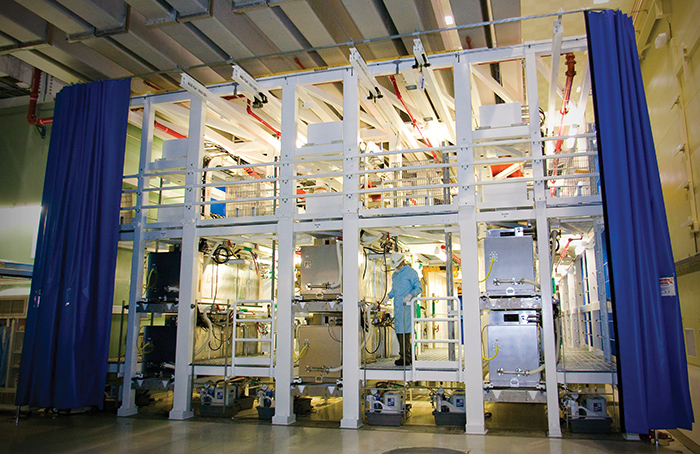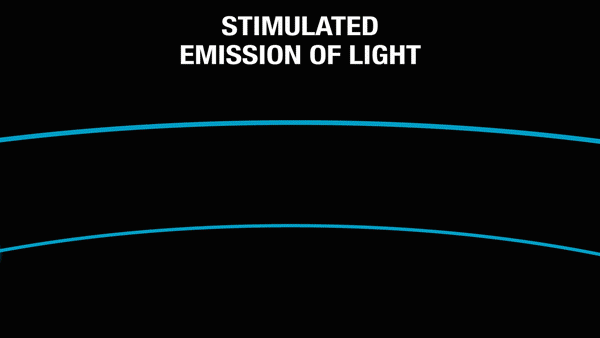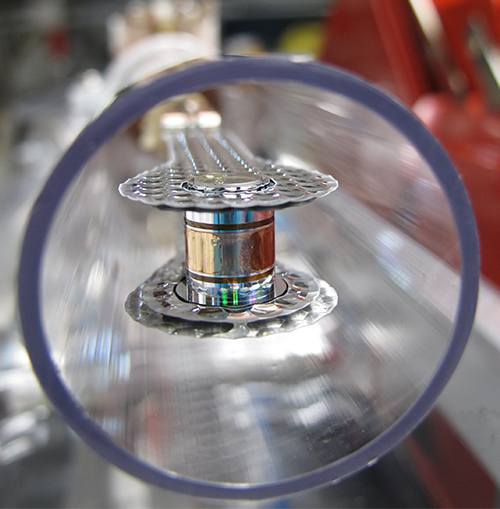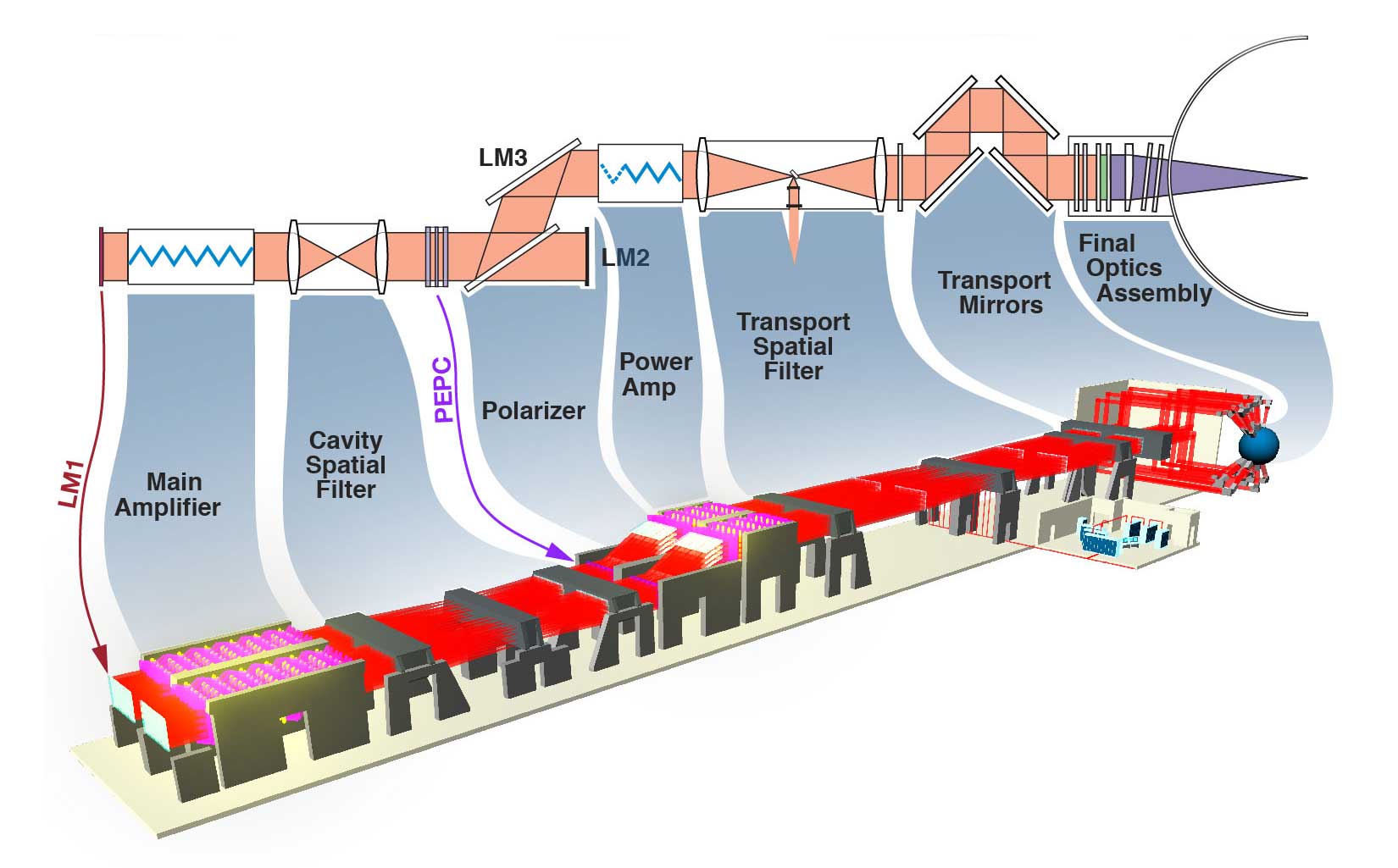How NIF Works
What happens when 192 of the world’s highest-energy lasers converge on a target the size of a peppercorn filled with hydrogen atoms? Answer: the same thing that happens inside the Sun and the stars: fusion! NIF’s laser beams can create nuclear fusion in the laboratory by generating the same kinds of temperatures and pressures that exist in the cores of stars and giant planets and inside nuclear weapons (see Anatomy of a NIF Shot).
We use NIF’s lasers for several specific missions, including Stockpile Stewardship, high energy density science, Discovery Science, energy security, and building future generations of scientists. And we’re researching more types of applications, including advanced lasers and photonics, additive manufacturing, and missile defense.
At the outset of a NIF experiment, a weak laser pulse—about 1 billionth of a joule—is created, split, and carried on optical fibers to 48 preamplifiers that increase the pulse’s energy by a factor of 10 billion, to a few joules. The 48 beams are then split into four beams each for injection into the 192 main laser amplifier beamlines.
Guided by laser mirrors (LMs 1, 2, and 3), each beam zooms through two large glass amplifiers, first through the power amplifier and then into the main amplifier. In the main amplifier, a special optical switch called a plasma electrode Pockels cell (PEPC) traps the light, forcing it to travel back and forth four times, while special deformable mirrors, spatial filters, and other devices ensure the beams are high quality, uniform, and smooth (see The Seven Wonders of NIF).
From the main amplifier, the beam makes a final pass through the power amplifier. By now, the beams’ total energy has grown from 1 billionth of a joule to 4 million joules—all in a few millionths of a second.
 NIF’s preamplifier modules are unique and complex lasers in themselves. They take the nanojoule-level laser light from the master oscillator, amplifiy it more than a billion times, and set its spatial profile before injecting it into the main laser beampath.
NIF’s preamplifier modules are unique and complex lasers in themselves. They take the nanojoule-level laser light from the master oscillator, amplifiy it more than a billion times, and set its spatial profile before injecting it into the main laser beampath. The 192 beams proceed to two 10-story switchyards on either side of the Target Chamber where they are split into quads of 2×2 arrays by a series of transport mirrors (see Beam Transport). Just before entering the Target Chamber, each quad passes through a final optics assembly, where the laser pulses are converted from 4 million joules infrared to more than 2 million joules ultraviolet energy, and focused onto the target. NIF’s 192 laser beams travel about 1,500 meters from their birth to their destination at the center of the spherical Target Chamber. Yet the journey from start to finish takes only about 5 microseconds.
How NIF’s Lasers Work

In a sense NIF, the world’s largest and highest-energy laser system, is one big laser amplifier. As with most large lasers, NIF uses intense flashes of white light from giant flashlamps to “pump” electrons in large slabs of laser glass to a higher-energy state that lasts only about one-millionth of a second.
A small pulse of laser light “tuned” to the excited electrons’ energy is directed through the glass slabs. This laser pulse stimulates the electrons to drop to their lower, or ground, energy states and emit laser photons of exactly the same wavelength.
This process produces huge numbers of photons of the same wavelength and direction—an extremely bright and straight beam of light. The initial low-energy pulse is amplified by more than a quadrillion times to create 192 highly energetic, tightly focused laser beams that converge in the center of the Target Chamber (see How Lasers Work).
 NIF targets are precisely controlled in a cryogenic cooling system that keeps the deuterium-tritium fuel frozen inside a millimeter-sized capsule.
NIF targets are precisely controlled in a cryogenic cooling system that keeps the deuterium-tritium fuel frozen inside a millimeter-sized capsule. How NIF Targets Work
In a NIF ignition experiment, a tiny capsule containing two forms of hydrogen, deuterium (D) and tritium (T), is suspended inside a cylindrical x-ray “oven” called a hohlraum. When the hohlraum is heated by NIF’s powerful lasers to temperatures of more than 3 million degrees Celsius, the resulting x rays heat and blow off, or ablate, the surface of the target capsule, called the ablator. This causes a rocket-like implosion that compresses and heats the DT fuel to extreme temperatures and densities until the hydrogen atoms fuse, creating helium nuclei (alpha particles) and releasing high-energy neutrons and other forms of energy.
If the implosion is symmetrical and compression and temperature in the “hot spot” at the center of the capsule are sufficient, the resulting alpha particles will spread through and heat the surrounding cold fuel, triggering a self-sustaining fusion reaction. This process can generate energy equalling or exceeding the energy delivered to the target, a condition known as ignition (see Achieving Fusion Ignition).
Next Up: Power Conditioning System




